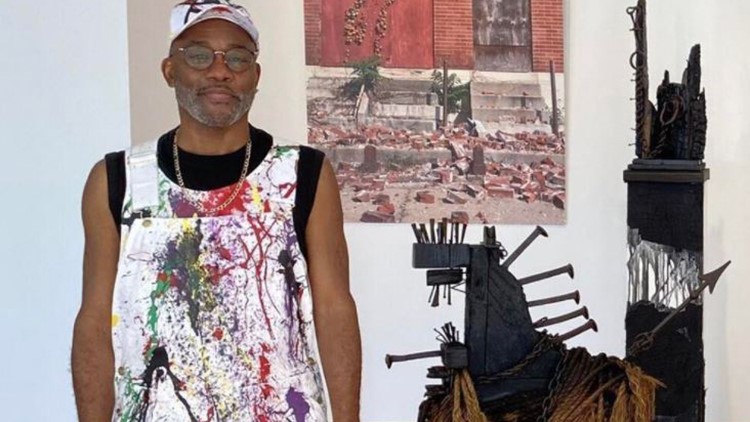Young joined moderator Jade Powers, assistant curator of the Kemper Museum of Contemporary Art in Kansas City, in a discussion at The Kranzberg Arts Center on Aug. 14 about his exhibition “The Prevalence of Ritual.” It is on display by appointment on Eventbrite until Saturday, Sept. 4.
His current body of work is a multidisciplinary exhibition that examines the idea of power objects, which is the spiritual belief that spirits exist in materials. Power objects derive from the collective consciousness rooted in African Americans with respect to Sankoka (an African custom that one must understand their past before moving forward).
“We all have things that we’ve collected over the years that belong to relatives that have gone on and for whatever reason we cherish those objects,” Young said. “That object has been touched by that individual and because that object has been touched by that individual it has a spirit.”
The meaning behind that concept inspired Young to incorporate those beliefs into his craft after completing a residency in South Africa in 2019. Those very principles are apparent in his current pieces.
“The power objects as far as the African diaspora masks, Nkisi n Kondi (ancestry figurines) are the objects that have nails in them and the cause of these objects have a spirit,” Young said. “What I began to see is that when I was creating these objects the nails began to appear, they had a meaning to me because they were so strong and powerful.”
As Young started using the nails in part of his work, he wanted to create a narrative and realized that while crafting them his grandfather, too, used old tools. It was his responsibility to get them to him, in the process he played around with them.
“What I began to understand is when I was creating these pieces visually and I could hear him talk,” Young said.
His three anchor pieces “Gatekeeper,” “Knowledge of Self” and “Wake Up Every Morning (Tied to the Post),” each narrate different dynamics he felt were imperative to tell visually.
“Knowledge of Self” highlights his journey as an artist on how he’s grown from the past to now. It also relates to interesting travel adventures he’s experienced around the world in Japan and Africa.
“The pie symbol itself signifies when I was at a temple in Japan, how there was marking to enter the temple, that’s my version of its objects in the container with bones, thorns and other things I collected in Africa,” Young said. “We’ve all taken our individual journeys as people to learn something about ourselves.”
“‘Gatekeeper’” is a fictional character modeled after animals he saw on a game reserve in South Africa.
“Gatekeeper is a culmination of materials and it's the essential object you transfer in order to get into the rest of the exhibition,” he said.
“Wake Up Every Morning (Tied to the Post)” represents everyone’s current circumstances whether they work, go home or have responsibilities. Young said usually those things are positive. But he decided to dive deeper into the topic by looking at it from the perspective of the sad reality the unhoused population has to exist in.
“Every time I travel, I see someone who is homeless,” he said. “Beyond that, when a person is homeless, their family is homeless. We often don’t see it that way. For the piece I connected building blocks and toys to signify children also being homeless if their caretaker is. The work is about the dysfunctional things I see in society.”
Young not only relied on elements he discovered in Africa’s natural habitat for the exhibits inclusion, he also found usage in items he saw while riding around in north St. Louis city.
“I’m seeing these deteriorating buildings and knew what I saw but I didn’t have a name for it,” Young said. “I learned that there were brick thieves — which were individuals who stole bricks from those buildings and they had developers who’d purchase them and use them for homes in southern states.”
Young said he experienced a lot of push and pull while figuring out the juxtaposition of every component in the exhibit, but he thought it made more sense to allow the materials to dictate their own narrative.
“When I started the assemblages the materials dictated the narrative,” Young said. “When I would go out in the community and find these objects literally I would take them back into my studio and I had to let them dictate which way they wanted to go. Especially with the charred wood because a lot of the bottom stuff is fragile. Everything was trial and error even with the African masks, I had to let the ropes and chains create this movement experience from South Africa.”
While curating the exhibition he realized it was likely that no one but him would conceptually understand the meaning behind it all.
“I had already built what it was gonna look like,” Young said. “In curating the show I knew certain things were gonna be in certain places and it came together organically.”
For more information about the exhibition visit https://www.kranzbergartsfoundation.org/events/ronald-young-the-prevalence-of-ritual/.


